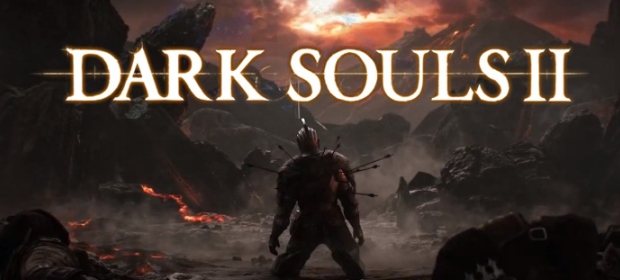It is a very simple ethos that drives Dark Souls II, and it’s one that will serve you just as well in real life: no matter what lies before you, you must keep moving forward. Within the very heart of Dark Souls II, these words echo even louder than they did before. That From Software’s newest adventure is punishingly hard will be no surprise to some (hell, if you’re a series fan, that’s exactly the reason you’re playing it), but the subtle changes will scatter tiny bones of contention everywhere for the gaming community to gnaw on.
The first and most apparent change is that for the first time in the franchise, there’s a coherent story. It may still be bare bones and mostly informed by the individual’s imagination, but there’s a solid framework to give what you’re doing some context. It begins with your nameless and faceless (for now) protagonist on a journey through a dark, gloom-entrenched forest. You are a Cursed Undead, bearer of the Dark Sign and destined to die over and over until the lest vestiges of your humanity are finally gone and you become “Hollow”. To stave this off, you make the pilgrimage across world to a land where the souls of the slain can preserve your sanity. The decrepit kingdom of Drangleic is beset by darkness, and freeing it might just be enough to change the fate of the Cursed.
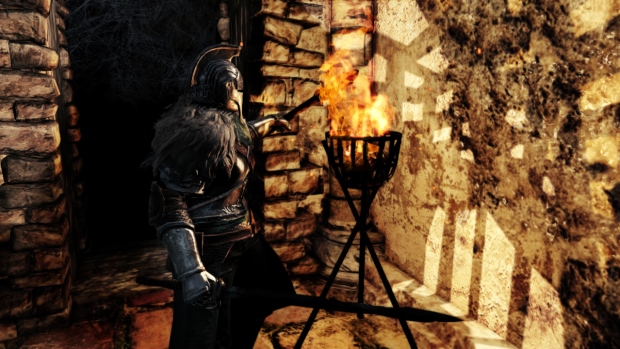
To facilitate the more involved story, Dark Souls II presents a more populated world – which is not to say it’s any more friendly. The biggest difference is that, from the outset, you feel a part of something; you don’t feel like an interloper. People talk to you with some level of respect. They are relying on you, though exactly why and what for is not always apparent. Fans will spot connections between this game and the last, most notably the mentions of Fire Keepers and recurring items, enemies and lore (One particular boss around ten hours in gave me shudders with his resemblance to one half of Dark Soul’s most villainous duo).
There are eight classes to choose from, representing the usual spectrum of RPG mainstays from the melee-heavy Swordsman or Knight through to the Miracle-slinging Cleric and the Sorcerer (who now gathers both spells and pyromancies under a single pointy hat). The reduced number of classes allows a greater focus, with less generalisation and a better opportunity to create a specialist. You could always opt for the Deprived if you’re brave enough, who starts with nothing but is easier to customise.
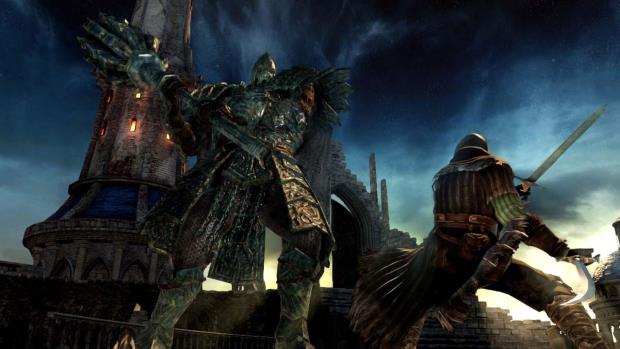
Immediately upon entering the small tutorial area, you’re reminded that this is the same universe, if not the same exact setting, of the first Dark Souls. The sepulchral murk is oppressive, and even the lowly hollows who set upon you here are initially tough to put down. As is now expected, Dark Souls II explains next to nothing about its world or what you’re supposed to be doing. You can light a torch at bonfires, which can then be used to ignite sconces and braziers throughout the game – but the ultimate purpose of this isn’t revealed. Maybe it’s just because fire is innately comforting. It’s a theme throughout, as you’ll often find items that have no apparent use, or hear cryptic warnings from NPCs that may pertain to things you won’t see for hours.
It doesn’t take long to realise that nearly everything in the world wants to kill you, and the combat is balanced in such a way that even the vanilla nasties must be approached with caution. If you attempt to button mash, you will fail in Dark Souls II and, considering how fervently the game tries to make you fail, it really seems to hate failure. Every mistake is punished severely, and the only way to survive Drangleic is to get good. It’s rare to see a game with such a focus and reliance on player skill.
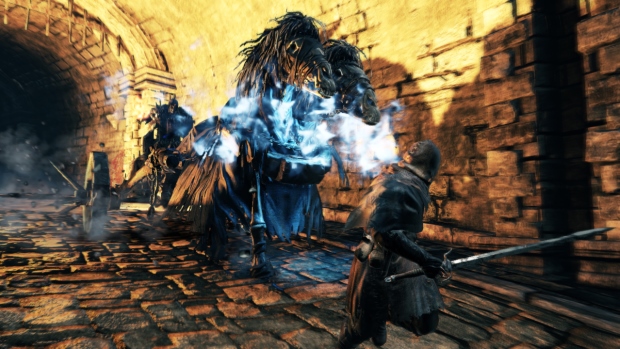
The combat has been tweaked in several areas. For a start, the quick-kill backstab has been removed, which won’t please many fans. You can still execute a powerful attack from the back, but it’s harder to pull off and leaves you more vulnerable to reprisals from behind. No matter your choice of weapon (though sword & shield still seems the most effective), you can give or weather damage, but dual wielding or ranged combat feel more balanced and efficient now, while magic is less overpowered. Piling on the armour is still not recommended without a high enough “Equip Load” rating, and the best way to mitigate damage is to not take it in the first place. Get used to evading, blocking and counter-attacking, or you won’t last very long. The worst moments in Dark Souls II come when you inadvertently stumble off a cliff because of imprecise foot placement, or you walk into a mist-shrouded door and get one-shotted by the boss you simply weren’t prepared for – though both can be avoided by the patient gamer.
Similarly to Demon’s Souls, repeated deaths will see your life bar drained permanently until you use a Human Effigy to restore your humanity. Reading between the lines, this means it’s very possible to reach a point where you’re stuck at fifty percent health. The difference this makes to gameplay is exponential, especially when you consider that you begin with no Estus Flasks and must contend with consumable Lifegems to restore your health. Resource management becomes essential, and you’ll find yourself pushing on without healing after a fight just to preserve what little curatives remain to you. Spell uses, should you opt for that path, are similarly finite, and doomed is the spellcaster who finds himself (or herself) a long way from the bonfire and out of herbs.
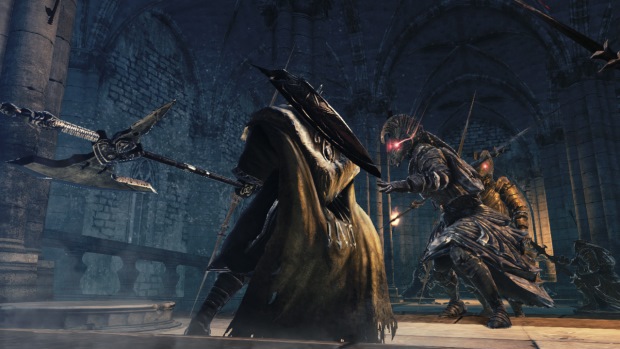
This design decision is intentional, and ties in with the biggest major change From Software have introduced: repeated deaths or trips to the bonfire will gradually stop some enemies from respawning. The effect of this is double-edged: on one side, it clears the way for runs back to a tough boss and removes obstacles from your path; on the other side, it severely hamstrings the possibility of grinding levels and farming souls. Consider that for a moment: you’re stuck on a boss who is impassable at your current level. Not only are you out of Effigies and Lifegems, but you’ve died eight or nine times and some of the enemies have stopped respawning – now how the hell do you proceed? At this point, if not before, you will know despair. There is an item that can be burned at a bonfire to reset the spawning cycle – but it will increase the challenge of every returning monster. Essentially, this is like activating a New Game+ mode mid-playthrough. Enemies will drop more souls, meaning it becomes potentially easier to level up, but they’ll be much harder to kill and the effect is irreversible.
My first attempt lasted eight hours, within which time I foolishly squandered all my Lifegems and Effigies and found myself stuck on a particularly nasty boss named The Pursuer. I was, I believed, absolutely mired – to the point where frustration overcame me and I burned the character by ruthlessly murdering NPCs in my hate-rage, just in case they dropped anything worth using. It was only when talking to someone else playing the game, whose adventures had taken different turns to my own, that I realised there were other ways available from the very beginning. As we traded stories and experiences, advice and guidance, we began to realise that Dark Souls II wants you to feel that all hope is lost – but it also wants you to grit your teeth and keep going. I learned a valuable lesson through that experience, and started again with a new character. Through the exchange of information with other gamers, Dark Souls II becomes a co-op experience even when you’re offline, and water cooler moments are common as each player’s experience is unique.

However, keep an open mind and you’ll rarely reach a dead end. As in Demon’s Souls, you strike out from a central hub – this time the coastal settlement of Majula – to which you can return to level up at the Emerald Herald, or visit the Blacksmith to upgrade your gear. Interestingly, you can now fast travel between any two lit bonfires from the off, so returning to previously barred areas when you’re strong enough or equipped with the right gear or key is easier. It doesn’t greatly alleviate difficulty, but does reduce the tedium of backtracking. There are several routes to take from Majula, and unlike Dark Souls it seems that enemies level alongside you, so you can potentially survive regardless of which route you take, though one path in particular seems to be easier in terms of the first boss you meet. The level design is incredible, so intuitive that even with no map of any kind, you don’t get lost. You don’t even realise you know your way around until you start thinking about the next place you need to return to. This game is even bigger than the last, and your quest to collect four Great Souls will take a massive investment of time and patience.
The inherent loneliness of the campaign is offset by the multiplayer element. Taking cues from both previous games, Dark Souls II’s online component is deeper than either. Covenants now link players in a kind of leaderboard system, where the turning-in of awestones earned in PvP grants kudos. There are Covenants that encourage the invasion of other worlds, and Covenants that have you swear to protect or aid other gamers wherever possible. Repeatedly assaulting other worlds will see you marked as a sinner, and players of certain Covenants will be charged with (and rewarded for) hunting you down. The PvP element is much improved, while the cooperative side remains mostly unchanged: you still leave summon signs so you can be called upon to help other players, whereupon you will share the spoils.
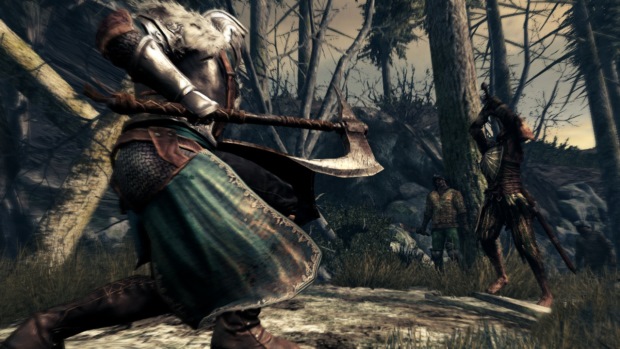
And there are times when you will need help. You must be human to summon AI phantoms to aid you, but it seems other players can be summoned no matter your condition – and some of the bosses make teaming up essential. Dark Souls II will come at you sideways, dropping bosses on you in frightening succession. In just your first twelve to fifteen hours you can meet upwards of six progress-impeding behemoths that will test your skill and resolve to the limit, and the weak-willed or casual player is unlikely to keep going back. Yes, Dark Souls II wants you to fail, and yet its punishing allure is hard to resist for those who crave a challenge. The trade-off between soul-destroying frustration and the unbridled elation when you finally put a tough boss down or even just reach the next bonfire is something that most games just aren’t capable of delivering.
Exploration is encouraged at all times, as is experimentation. Despite the messages left by other players and the ghosts that reveal their grisly ends, the only way to know what lies around the next corner is to go there, shield up and have your senses on high alert. Item use is treated the same way, as some things don’t reveal their effects at all. The forums will come alive with theory crafters as players attempt to make sense of From Software’s shadowy, enigmatic world.
The new engine handles the action very well, and the frame-rate is noticeably smoother. The environments are highly detailed and dripping with atmosphere, whether you’re basking in the majestic Majula sunset or picking your way across the corpse-strewn battlements of some crumbling redoubt. Shadows play tricks on your eyes, and the amazing audio is designed to unsettle you with sudden footsteps, distant groans, and scraping flagstones. Played in the dark with headphones on, Dark Souls II is one of the most immersive experiences available on console.
Criticising Dark Souls II for being hard is like criticising Need for Speed for asking you to put your foot down, and the design is such that every challenge can be overcome. Every boss can be beaten, every area can be traversed, but some of the changes can make achieving either incredibly taxing. There are times when Dark Souls II feels unfair, and there will be moments when you find yourself cursing it for being cheap, but ultimately the balance is close to perfect, and the better you get at reading enemies and controlling your character’s movements, the more you’ll enjoy the game. The first time you die on a new boss and your immediate reaction is “Enjoy that victory, I’ll be right back!”, you’ll know that you’re finally getting it.
VERDICT: A certain amount of Dark Souls II is reliant on trial and error – it’s simply unavoidable. This is a quest into the unknown, and you won’t know how to deal with what comes at you out of the shadows until its blasting its fetid breath down your neck and sliding its claws right into your soul – but it’s intentional. The very premise of the Cursed Undead lends the template not only context but also a degree of gravitas: your character is fated to die, again and again, until they either succeed in their quest or go insane trying – a doom shared by every gamer who resolves to tackle From Software’s gargantuan RPG. Dark Souls II is a true hardcore challenge, and the weak of will and spine have no place in its cruel and unusual world.

INCREDIBLE. This is the pinnacle of our scoring spectrum, reserved for games that truly affect us, that capture our imagination so completely that they affect the standard by which we measure future games. 10/10 is not a declaration of perfection, but an assurance that the game in question is of amazingly high quality and has exceeded our expectations.


